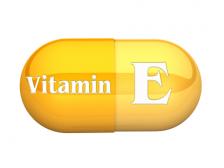Vitamin E: Are You Getting What You Need?
There’s more to vitamin E than meets the eye. Nutrition Diva explains how this group of nutrients protects your health, and how to be sure you’re getting enough.
This week, I want to shine the spotlight on vitamin E, a nutrient that doesn’t get nearly enough attention. Not only does it have a host of important benefits, but it’s one of the most common nutrient shortfalls. Although you don’t need all that much (just 15 mg per day), nine out of ten Americans still fall short on vitamin E.
So, let’s take a closer look at this overlooked nutrient: what it is, what it does for you, and how to get more of it.
Sponsor: Visit GoDaddy.com to get your $1.99 .COM domain. Some limitations apply, see website for details.
 What is Vitamin E?
What is Vitamin E?
When people talk about vitamin E, they are usually referring to the compound known as alpha-tocopherol. However, there are also 7 other forms of vitamin E: beta-, gamma-, and delta tocopherol, and alpha-, beta-, gamma-, and delta-tocotrienol.
At least, that’s what I learned in nutrition school…but since then, they’ve actually added two more forms: epsilon-tocopherol and epsilon-tocotrienol. This was right about the same time that they decided we only had eight planets in our solar system and not nine, as we did when I was in grade school. It’s hard to keep up!
What Does Vitamin E Do?
All forms of vitamin E are fat-soluble antioxidants. However, they appear to have several different functions in the body–some of which have nothing to do with fighting free radicals. We know the most about alpha-tocopherol; this was the first form of vitamin E to be identified, and is the primary form found in our bodies.
In its antioxidant role, alpha-tocopherol protects cell membranes from oxidative damage, shields the skin from ultra-violet rays and environmental pollutants, and helps prevent oxidation of LDL cholesterol in the arteries, thereby lowering heart disease risk. Alpha-tocopherol further protects the heart by keeping the blood from getting too sticky.
We’re still learning about the other tocopherols. Gamma-tocopherol is the form most commonly found in plants, but it doesn’t seem to stick around in our bodies the way alpha-tocopherol does. Some research suggests that gamma-tocopherol may protect against prostate disease. The other forms haven’t been linked to specific health benefits yet, so they may be biologically inert, or simply play supporting roles.
What are Tocotrienols?
We know even less about the other branch of the family, the tocotrienols–although a burst of recent research is starting to close the gap. Again, the different forms appear to target different organs. Gamma-tocotrienol appears to have potent cholesterol-reducing abilities, for example, while alpha-tocotrienol may play a special role in protecting brain cells.
How Much E Do You Need to Be Healthy?
The recommended intake for vitamin E is 15 mg of alpha-tocopherol a day. (At present, there are no recommended intakes for the other forms.) Fifteen milligrams isn’t a whole lot–and yet 90% of us aren’t getting that recommended amount. This is not an argument for supplements, however.

Not only that, large doses of alpha-tocopherol actually lower blood levels of other forms of the vitamin–another argument for getting our nutrition from foods instead of supplements.
See also: Can You Get Too Many Antioxidants?
Foods that are high in vitamin E typically contain several different forms of the vitamin, in varying proportions. For example, sunflower seeds–a palmful of which contains an entire day’s supply of alpha-tocopherol–also provide smaller amounts of beta- and gamma-tocopherol. Pistachios, on the other hand, contain a smaller dose of alpha-tocopherol, but are very rich in gamma-tocopherol and gamma-tocotrienol. Brown rice offers a modest amount of tocopherol, with a healthy dose of mixed tocotrienols.
Click here to see my vitamin E cheat sheet, which lists good sources of the vitamin. As you can see, nuts, seeds, vegetable oils, and whole grains are the main players in the vitamin E game. The chart also shows you how much of the different forms various foods provide.

See also: How Important is a Varied Diet?
References
Helzlsouer KJ, Huang HY, et al.:Association between alpha-tocopherol, gamma-tocopherol, selenium, and subsequent prostate cancer. J Natl Cancer Inst. 2000 Dec 20;92(24):2018-23.
Sen CK, Khanna S, Roy S. Tocotrienols: Vitamin E beyond tocopherols. Life Sci. 2006 Mar 27;78(18):2088-98.
Photos of Vitamin E and Mixed Nuts courtesy of Shutterstock.


 What is Vitamin E?
What is Vitamin E?



